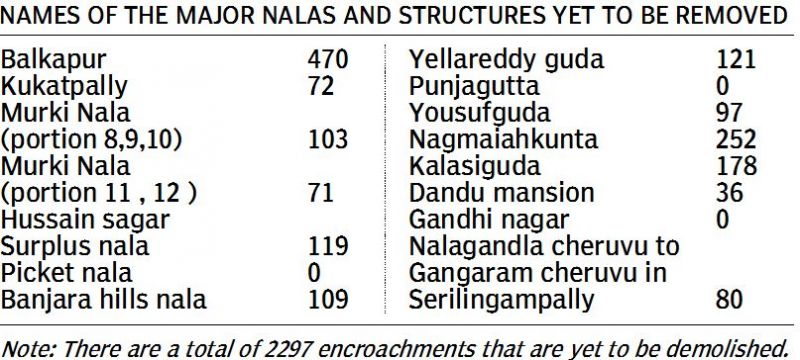GHMC fails to curb illegal encroachments in Hyderabad
Out of 25 prime storm water drains that connect the city to the Musi, the GHMC has not cleared 14.

Hyderabad: In the wake of the mini floods in 2016, the GHMC was to dismantle the encroachments on crucial nalas. But 11 months later, it has managed to dismantle just 853 encroachments of the 3,150 that were on the demolition list. Some 2,297 structures that have narrowed down the storm water drains are still standing.
Out of 25 prime storm water drains that connect the city to the Musi, the GHMC has not cleared 14. The Balkapur and Hussainsagar surplus nala and the Banjara Hills nala have narrowed considerably, than-ks to the unchecked gro-wth of illegal buildings.
The mini floods episode of September 2016 was repeated on August 25 this year. The same areas — Bandari layout in Quthbullapur, and Dee-pthi Sree Nagar in Madinaguda — were inu-ndated because the GHMC did not carry out the work it was supposed to.

The stormwater drain running from Fox Sagar in Jeedimetla to Fatheh- nagar (chemical nala) in Quthbullapur circle has 184 obstructing structures. A GHMC survey identified an illegally constructed multi-storied vacant building at Subash Nagar, owned by Malkajgiri MP Ch. Malla Reddy, in the buffer zone of Fox Sagar.
The drain from Kapra cheruvu to Nagaram cheruvu in the Kapra circle has 220 illegal buildings. The nala from Kalaniketan to River Musi has 110 blocks, obstructing the flow of water.
The municipal authorities couldn’t remove a single structure at Banjara Hills, Yellareddyguda, Punjagutta, Yousufguda, Nagamaiahkunta, Kalasiguda, Dandu mansion, Gandhi nagar and six other localities. The excuse is that encroachers have approached the court and got a stay, or there is a stiff resistance from encroachers, or they are not willing to be shifted and rehabilitated.
Vote bank politics stalls demolitions
Local elected representatives, who object to demolishing encroachments because it means becoming unpopular with their vote banks, are the main stumbling block when it comes to anti-flooding measures.
People are reluctant to move from their illegal constructions even when given alternative housing and their elected representatives support them. Politics thus is the main culprit, stalling or delaying demolition of encroachments.
In March 2017, the GHMC planned a demolition drive on nalas under GHMC limits, but it has come to a grinding halt due to interference from local political leader from all parties.
Dr B. Janardhan Reddy, GHMC Commissioner explained, “Between 2007 and 2014, GHMC officials were able to evacuate 700 families who had encroached upon the nalas and rehabilitated them in JNNURM houses. In eight years, 700 structures were dismantled. However, the worry is why didn’t the corporation prevent these structures from being built? Once they are allowed, the inmates grow roots, earn a livelihood here and develop an emotional social environment. Later, they get a voter identification card and follow a public representative, who advocates for them. An illegal encroachment, it has to be prevented at the construction stage, since eviction is a big task.”
The GHMC’s strategy, he said, was to first identify the structure, estimate its value and provide compensation or ex-gratia from the government.

